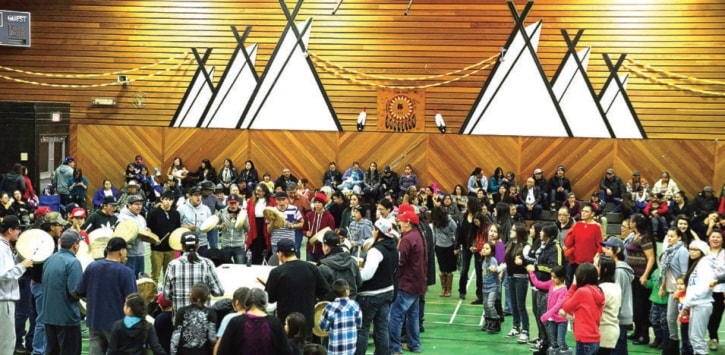Cree nations of Maskwacis, the newly officially recognized name of the territory formerly known as Hobbema, celebrated the restoration of the name of their ancestral land at the Peter Bull Memorial Centre until the small hours of the New Year’s day.
With representatives of various First Nations from other parts of Alberta joining the festivities, wave after wave of dancers performed the round dance to the rhythm of the drummers at the centre of the big hall as the final day of the year 2013 ticked off to its completion and gave way to 2014.
Throughout the night, there were give-aways and raffle draws for a variety of items as well as celebrations to recognize emergency and security staff ensuring safety and security of Cree nations.
Chief Marvin Yellowbird of Samson Cree Nation, who officially applied to the Ministry of Municipal Affairs last summer to gain recognition for the ancestral name of the territory on behalf of the four nations, said the change of the name was “of great cultural and spiritual significance in terms of defining who we are as Maskwacis people.”
“From time immemorial, we have always been the people of the Bear Hills and we came by treaty to our rightful place in this land as we are the Maskwacis people.”
“The term Maskwacis means bear hills,“ continued Yellowbird.
“We are connected to the land and as people of the bear hills, I think it (the restoration of the name) will strengthen our spirituality as well as our cultural heritage in terms of moving forward and bringing the four nations, Samson, Ermineskin, Louis Bull and Montana together as one Maskwacis Nation,” he concluded.
Chief Craig Mackinaw of Ermineskin Cree Nation was equally jubilant.
“Now that we have got our traditional name back, we can start following our ways, do the things we have always wanted to do and we don’t depend on the name Hobbema any more, which is good for all of us,” Mackinaw said.
“It (the name change) will now start the process of looking at the past and at what we have now, moving on with learning more about our culture, practicing it and passing it on to our youth,” he concluded.
The combined reserve land base of the four First Nations collectively known as Maskwacis Cree is comprised of some 319.8 square kilometers located in the area known as Maskwacis and Pigeon Lake. The Neyaskwayak (the Northern treeline) or Ermineskin Cree Nation, Kispahtinaw (the end of the hill) or Louis Bull Tribe, Akamihk (across the river) or Montana First Nation, and Nipisihkopahk (willow meadows) or Samson Cree Nation have been campaigning for the name change for almost two years.
It was in March 2012 that Marvin Yellowbird and 11 of the 12 council members of the Samson Cree nation signed a document stating they were re-affirming their power over traditional territory. Their statement was supported by Ermineskin Cree, Louis Bull Tribe and Montana Band.
Since 1891, Maskwacis was referred to as “Hobbema”, after a Dutch landscape painter who was admired by the then President of the Canadian Pacific Railway. When the railway line between Edmonton and Calgary was built, he chose “Hobbema” as the name for
the flag station established in Maskwacis territory.
Samson Cree declared early in the fall that they had been notified by the provincial government that their request for the change of the name of territory was approved and would be effective as of Jan. 1, 2014.
